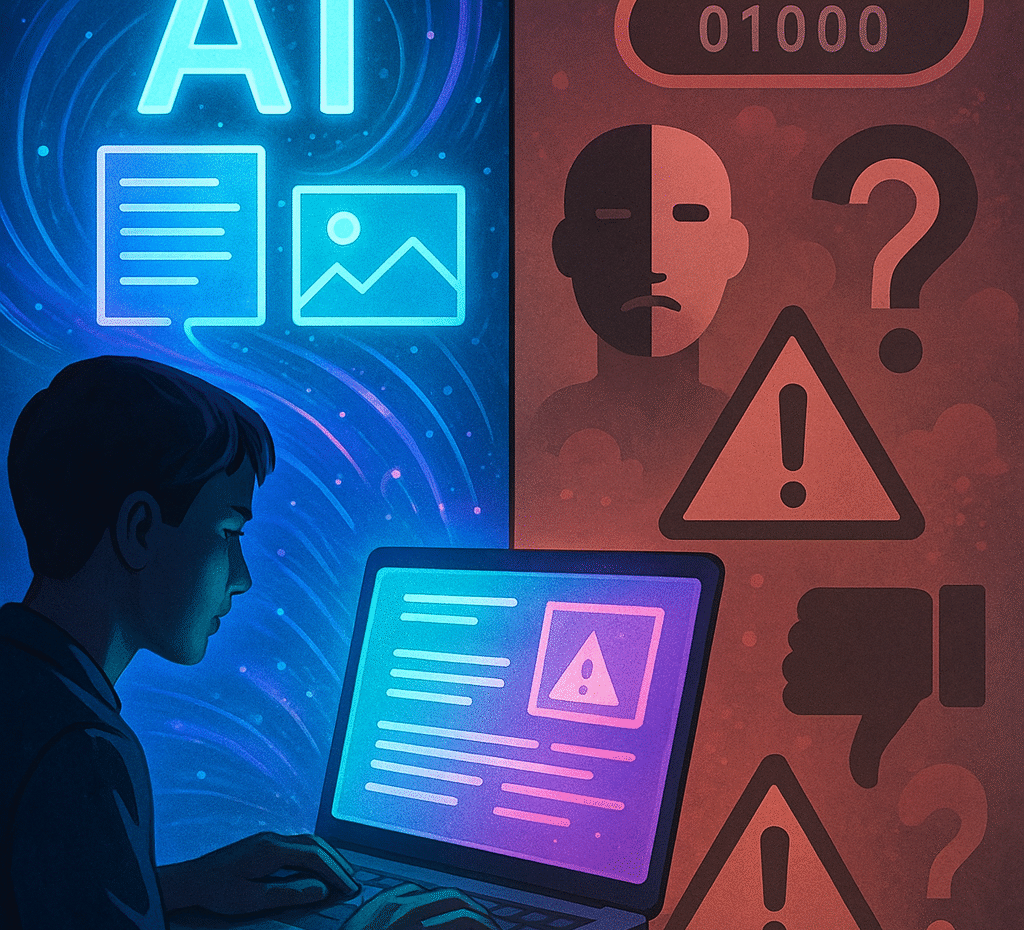- June 23, 2025
- by admin
Generative AI: The Power and Pitfalls of Tools Like ChatGPT
In just a few years, Generative AI has gone from experimental to essential reshaping how we work, create, and communicate. Tools like ChatGPT, Midjourney, and GitHub Copilot are no longer tech novelties they’re becoming integral to business, content creation, education, and software development.
But with this newfound power comes a wave of challenges ethical, technical, and practical. As we rush to embrace AI tools for their incredible capabilities, we must also ask: What are the hidden costs? Where are the boundaries? And how do we use them responsibly?
Let’s dive into the promise and problems of Generative AI one of the most transformative (and disruptive) technologies of our time.
⚡ What is Generative AI?
Generative AI refers to models trained to create new content text, images, code, music, or even video based on patterns they’ve learned from large datasets.
Tools like:
ChatGPT generate human-like text
DALL·E and Midjourney create art and visuals
Runway and Sora produce AI-generated video
GitHub Copilot assists developers by writing code in real-time
These models don’t just analyze they create. That distinction is why they’re revolutionizing creative workflows, automation, and innovation across sectors.
✅ The Power: Why Generative AI Is a Game-Changer
1. Content Creation at Scale
Marketers, writers, and designers can generate drafts, captions, visuals, and emails in seconds. This reduces content bottlenecks, enables faster campaigns, and even opens creative work to those without traditional skills.
Example: A startup with no full-time designer can now create ad creatives with just a prompt and a click.
2. Enhanced Productivity
Developers use tools like Copilot to autocomplete code, troubleshoot bugs, and improve development speed. Analysts use AI to summarize reports, extract insights, or generate dashboards.
Repetitive work is minimized, giving professionals time for strategic tasks.
3. Democratizing Access
AI tools lower the barrier to entry. Non-coders can build apps with AI. Non-designers can produce polished visuals. Language learners can practice fluency with chatbots. This leveling of the playing field is empowering individuals and small teams like never before.
4. Education and Learning Support
Students use ChatGPT to understand complex topics. Educators use it to design lesson plans. AI tutors can adapt to different learning paces and styles offering personalized learning experiences.
⚠️ The Pitfalls: Where Generative AI Gets Risky
For all its strengths, Generative AI also brings serious concerns that can’t be ignored.
1. Misinformation and Hallucinations
AI doesn’t know what’s true it generates based on probability. ChatGPT and similar tools can confidently fabricate facts, misquote sources, or present false data.
Problem: Users may assume generated content is verified when it’s not.
Solution: Always fact-check and use AI as a starting point, not a source of truth.
2. Plagiarism and Intellectual Property
Generative models are trained on vast datasets, which often include copyrighted material. AI art and writing may mimic existing styles without attribution, creating legal and ethical gray areas.
Who owns AI-generated content?
Are artists being unknowingly copied?
This is an ongoing debate and one that courts are beginning to address.
3. Bias and Fairness
AI models learn from real-world data and that data often reflects human biases. Whether it’s racial, gender-based, or cultural, these biases can appear in generated content.
Example: Prompting an image generator for a “CEO” may yield mostly male results.
Fixing bias requires diverse training data, transparent audits, and user education.
4. Over-Reliance and Skill Degradation
The convenience of AI can lead to dependence. Writers may stop editing. Designers may stop sketching. Students may stop learning the hard way.
The key is to use AI as a collaborator, not a crutch.
👩💻 Real-World Applications: Where ChatGPT and Others Are Making Impact
| Industry | Use Case |
|---|---|
| Marketing | Social media posts, blogs, ad copy |
| Software Dev | Code generation, bug fixes, documentation |
| HR | Job descriptions, candidate screening, onboarding |
| Education | Tutoring, lesson planning, and quiz creation |
| Customer Support | Chatbots, email replies, and help center content |
What used to take hours now takes minutes. But speed doesn’t always mean quality, and that’s where human oversight matters.
🔐 The Responsibility Factor: AI Needs Human Judgment
Generative AI is not inherently good or bad it’s a tool. Its value or risk depends entirely on how we use it.
Principles for Responsible Use:
✅ Disclose when content is AI-generated
✅ Avoid using it for decisions with ethical consequences (e.g. hiring, legal advice)
✅ Train employees on when to trust, verify, or reject AI output
✅ Keep humans in the loop, especially where empathy, context, or nuance is required
🧭 What’s Next for Generative AI?
We’re only scratching the surface. Here’s what’s coming:
Multimodal models: Tools that combine text, image, video, and voice in a single interface (like GPT-4o or Sora by OpenAI)
Real-time co-creation: Think live brainstorming sessions with an AI collaborator
AI-native apps: Entire startups are being built around AI from the ground up
AI governance laws: Expect more rules on what AI can do and how it must disclose itself
The landscape is evolving fast and so must we.
💬 Final Thoughts
Generative AI tools like ChatGPT are reshaping what it means to think, create, and collaborate. They offer immense power but not without trade-offs.
To harness the best of AI, we must stay curious, cautious, and creative. We must pair the intelligence of machines with the judgment of humans. We must lead the AI revolution not be led blindly by it.
Because in the end, it’s not what AI can do that matters it’s what we choose to do with it.

